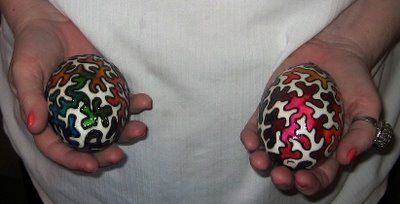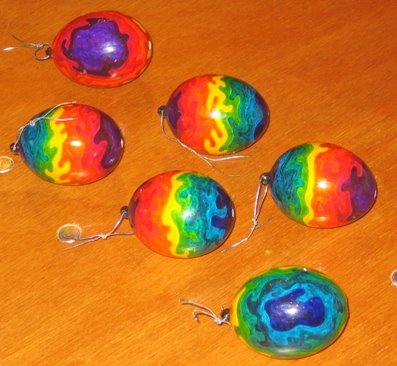The following is adapted from two entries in my personal blog.

The sign in the photo above doesn't look like anything special, does it? Covered up as it is right now, with a plastic banner advertising the day school, it appears to be nothing but a commercial sign. But if you were to pull off that banner, and peel back layers of paint, you would find something very different. Pastor John R. Smith of St. Michael's calls it the "
prophetic sign." The school banner will be down soon, and the prophetic sign will again broadcast its message to passersby.
If you've been reading my personal blog for a while, you may have noticed that I don't write about politics very much. Doing so properly would require a level of research I really don't have time for. And if I did write about it, someone would inevitably disagree with me. Then there would be arguments and harangues and debates, and I'd have to marshall even more facts for a follow-up entry, and...no. Sorry. It's not worth it to me. Now we can move on, to another subject I'm always nervous about covering - religion. And fair warning: politics are going to sneak in here a little bit, too.
About nine years ago, I decided that I was never going to figure out what I believed about God if I mostly ignored the subject outside of my nightly prayers. At the time I was reading non-fiction by Madeleine L'Engle, who for many years was writer-in-residence at an Episcopal cathedral in New York. The Episcopal / Anglican tradition came across in her work as pretty much everything I liked about the Roman Catholic Church, minus everything that had driven me away from Catholicism many years before. Besides, there was an Episcopal church just a couple of miles away from me. So I went there one Sunday. I've been going to St. Michael's ever since.
The reason I had noticed St. Michael and All Angels Church in the first place was that it had a sign out front that I liked. It was a line drawing in black paint of a man, a woman, a baby and a donkey, presumably the Holy Family fleeing to Egypt. Next to the picture were the words, "Jesus was a refugee." That sign made me like St. Michael's even before I drove into its parking lot for the first time.
But that's not the only message "The Church with the Sign," as it's sometimes called, has had on its famous sign. Back in the 1980s, before "Jesus was a refugee," the sign said, "It's a sin to build a nuclear bomb." For the Jubilee Year in 2000, it exhorted us to ask governments and other institutions to "Forgive the debts of the poorest countries." And since 2003 or 2004, possibly a little earlier, the sign has depicted a long line of children of many ethnicities. It says, "Either we are all God's children - or no one is."
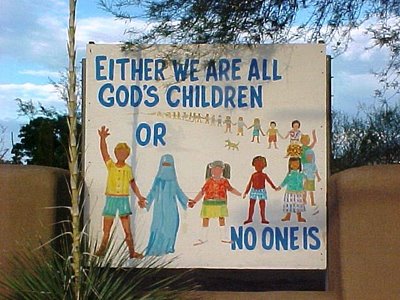
The sign in 2004.
Illegal immigration is a big issue in Tucson, which is about 100 kilometers from the Mexico border at Nogales. Every year, roughly a thousand people die in the Arizona desert, trying to get to a better life in the Land of Opportunity. If the heat and dehydration don't kill them, they are often victimized by "coyotes," people who smuggle immigrants in for money. At the first sign of trouble, coyotes tend to abandon their clients in the wilderness, or in the back of an overcrowded, unventilated truck. What do they care if some of the people don't arrive alive? The coyotes already have their money.
This is why a number of churches around Southern Arizona support organizations that try to save the lives of these people, most of whom are here to take jobs that few
Norte Americanos would want, especially at day labor wages. Groups like
No More Deaths don't encourage people to sneak into the country; but they don't want the border crossers to die, either. So volunteers set up and maintain water stations,
clean up trash along migrant routes, and administer first aid. This is all done in uneasy cooperation with the U.S. Border Patrol. The volunteers do not help the border crossers establish illegal residency, but they do render humanitarian aid.
Once in a while, though, humanitarian efforts clash with governmental ones. From the No More Deaths website:
Shanti and Daniel Fight Humanitarian Aid Charges
No More Deaths volunteers, Shanti Sellz and Daniel Strauss, both 23, were arrested by the U.S. Border Patrol for medically evacuating 3 people in critical condition from the 105-degree Arizona desert in July 2005.
Shanti and Daniel were following the protocol of NMD training (acknowledged by NMD and US Border Patrol) by consulting medical professionals who advised them to evacuate the critically ill men to a medical facility, and then consulting a NMD attorney who approved the evacuation.A pro bono attorney for Shanti and Daniel spoke at St. Michael's several months ago about their case. After church, she handed out lawn signs that said, "Humanitarian Aid Is Never A Crime." I certainly agree with those words, so at her urging, I took a sign home, although I explained that I would want to consult with my husband before putting it up. She told me to take one anyway, so I did - and put it in my closet.
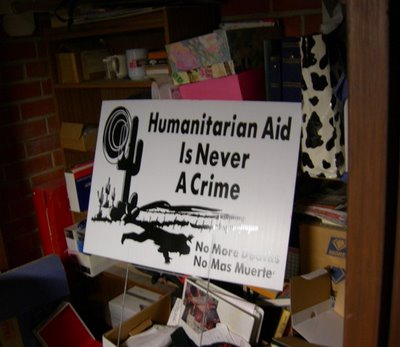
As of last night, the sign was still in my closet, although John had raised no objection to having it in our front yard. Unlike the woman who is currently in trouble with her homeowner's association for
displaying a Support Our Troops sign, I was worried about ticking off the neighborhood association or individual neighbors. Go ahead. Call me a moral coward. I'll probably agree with you. But we get neighbors anonymously reporting us to the city if the grass gets long, the pool gets dirty, or water leaks from a burst pipe. And people just don't have a lot of signs or banners up around here, unless you count the occasional flag --U.S., P.O.W./M.I.A., or Dale Earnhardt.
But in the past week or two, I've noticed that a few neighbors do have signs on their lawns - not just any signs, but this sign:
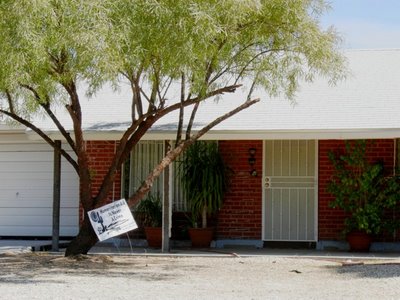

So I asked John if he would mind if I put up mine. He said he'd never had any objection in the first place, and to put it up if I want to. "Not that it will accomplish anything," he added, "except to alleviate your guilt."

I don't really believe that, so this afternoon I went home at lunch, and put up the sign. Here it is. And here it stays, for a while at least. The
trial of the NMD volunteers, previously set for January and then April, has now been
postponed indefinitely.
*****
This is my entry for this week's Round Robin Photo Challenge: "Obstruction," as suggested by Nancy of Nancy Luvs Pix. As it happens, it's also a follow-up to the previous RR Photo Challenge, "Signs."
 Despite the obstruction, a few of God's
Despite the obstruction, a few of God's
children manage to wave hi.Remember the St. Michael's "prophetic sign" I showed you last time? It's the one that says, "EITHER WE ARE ALL GOD'S CHILDREN...OR NO ONE IS." As you may recall, that sign has been covered up recently - in other words, obstructed - by a printed plastic sign advertising St. Michael's Parish Day School. You can just see a few children waving at the edges of the wooden one if you peek at the sides.
This past Sunday, I happened to notice that the plastic sign no longer covered the wooden one. I also noticed and remembered the other side of the sign, which is visible from the parking lot, a message to parishioners as we leave church. I set out to take a photo of both sides. The message "Go in peace to love and serve the Lord" is partially obstructed by the pale, thorny sticks of a dead ocotillo. This is appropriate, I think, because the prickliness of our own tempers often gets in the way of our being peaceful and loving.
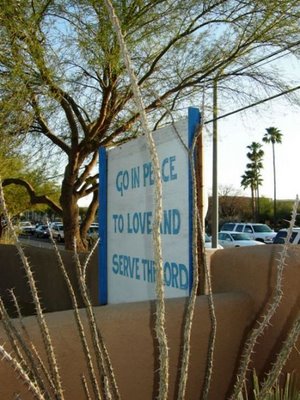 A message of peace, obstructed by thorns of ocotillo
A message of peace, obstructed by thorns of ocotilloAs I set out to photograph the back side of the sign, three of my friends waited for me in my car, including 100-year-old Eva. I had put the air conditioning on, but I didn't want to keep them waiting for long. So I took a few shots of the "Go in peace" sign of the sign, and left re-photographing the "God's children" side for another day. This was a mistake, it turns out. On Monday, the sign for the school was back.
 Nails in the wood hold down the second sign,
Nails in the wood hold down the second sign,
and obstruct the children's view.On Tuesday after work, I walked around and took more pictures of the sign from different sides, all the ones you see here and more. I thought about slipping a few of the grommets of the plastic sign off the nails that are holding it on, and getting a quick shot of the sign underneath before putting it back the way I found it. But it sounded tricky to do, and a lot of traffic was going by, and I was afraid people would think I was vandalizing the church. So I didn't do it.
While taking these shots, I discovered another sign. It's a Notice of Hearing before the City of Tucson's Sign Code Advisory and Appeals Board. It seems that St. Michael's is "requesting a variance to exceed the allowable sign area of twenty square feet frontage on Wilmot Road." The hearing took place on March 15th, but this is the first I've heard of it. Then again, I don't attend Vestry meetings.
 A notice of hearing about the famous sign,
A notice of hearing about the famous sign,
and noncomforming crosses.According to the notice, the St. Michael's prophetic sign is 20.5 square feet, just over the limit for a "Single Family Residential District, Public Uses and Churches" zone. (St. Michael's is next door to the hospital and the public library on one side, houses on the other. The other side of the street is all businesses and offices.) In addition, the notice lists St. Michael's as having "six noncomforming 'crosses,'" which it says have a total area of "31.3 square foot." The requested variance is to increase the allowed signage area enough to include the sign, the crosses, and more. The leftover square footage is probably for the temporary signs the church puts up from time to time to promote such events as the English Faire and the Advent Bazaar.
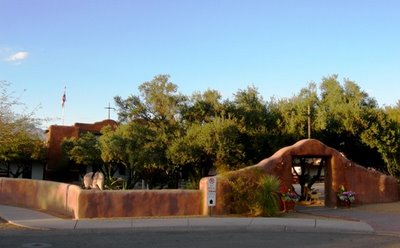 Two of the noncomforming crosses, as seen from the parking lot.
Two of the noncomforming crosses, as seen from the parking lot.Now there are two more points about this I find instructive - or rather, obstructive. For one thing, I can only find three "nonconforming crosses" at St. Michael's, at least without an exhaustive search. The ones I did find aren't right up against the "frontage" of Wilmot, anyway. One is over the end of the left wing of classrooms, one is over the arch that leads to the tree-lined walkway in front the the church proper, and one is directly over the church itself. They're not signs, either, in the sense of having words or pictures. They're crosses, and they're part of the architecture. Gee. Imagine a church having crosses on display! And from Wilmot Road, the view of the crosses I saw was partly obstructed anyway. So is the church itself, for that matter. What's visible from the street is mostly the school.
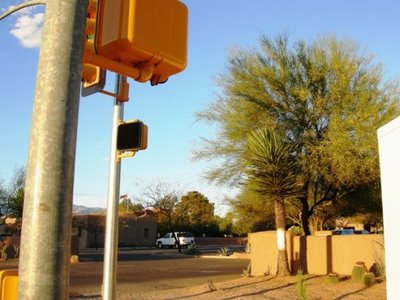 One of the crosses is near the white truck,
One of the crosses is near the white truck,
above and to the leftAnd the sign. That's very visible from the street. I have to wonder why this hearing took place just this month, when the wooden sign and the crosses have been there for many years. Did someone try to use zoning laws to achieve a political or religious purpose, namely the censorship of a sign the person found objectionable? Or was it simply a matter of the church trying to ensure it doesn't run afoul of city sign regulations in the future? I don't know, and I don't think I'm going to ask.
But I sure hope the Sign Code Advisory and Appeals Board agrees to the variance, and doesn't obstruct the church's ability to "sign" its messages to travelers on Wilmot Road.
Karen
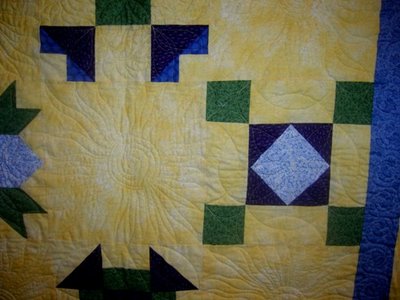
 Now, let's talk about Mâvarin. My first novel, Heirs of Mâvarin, is mostly about three specific characters, dealing with their own internal struggles while on their way to do things that affect the whole country. Religion exists basically in the background, and the politics have no contemporay equivalents that I'm aware of. Yet there's still a little social commentary buried in there, not because I deliberately put it in, but because it's part of the human condition. Rani, my most alienated (and ultimately most heroic) character, is black. That doesn't seem to have made him too much of an outsider or second class citizen growing up, but the fact that he grew up without a father is another alienating factor. It marks him as different, as much as his skin did in a nearly all-white community. Then when he becomes a tengrem (basically a monster), he's the ultimate outsider, alienated from humanity itself, and subject to being hunted down and killed. The fact that he is very much a "Them," even an "It," makes it more significant that Del sees past all that, and knows Rani is still his friend, still deserving of his compassion, affection and protection. At the same time, two "Them" groups that most people distrust, the tengremen (well, some of them) and the selmûnen, work together to help overthrow an illegal and oppressive government in favor of the rightful one. (This is the book that's currently awaiting a reply from a major publisher.)
Now, let's talk about Mâvarin. My first novel, Heirs of Mâvarin, is mostly about three specific characters, dealing with their own internal struggles while on their way to do things that affect the whole country. Religion exists basically in the background, and the politics have no contemporay equivalents that I'm aware of. Yet there's still a little social commentary buried in there, not because I deliberately put it in, but because it's part of the human condition. Rani, my most alienated (and ultimately most heroic) character, is black. That doesn't seem to have made him too much of an outsider or second class citizen growing up, but the fact that he grew up without a father is another alienating factor. It marks him as different, as much as his skin did in a nearly all-white community. Then when he becomes a tengrem (basically a monster), he's the ultimate outsider, alienated from humanity itself, and subject to being hunted down and killed. The fact that he is very much a "Them," even an "It," makes it more significant that Del sees past all that, and knows Rani is still his friend, still deserving of his compassion, affection and protection. At the same time, two "Them" groups that most people distrust, the tengremen (well, some of them) and the selmûnen, work together to help overthrow an illegal and oppressive government in favor of the rightful one. (This is the book that's currently awaiting a reply from a major publisher.) Fabi looked up through the rain at the jagged, snow-capped peaks of the Câlaren, stark holy places that reached far above the pillars of cloud. Even this late in the day, even in this weather, the snow gleamed as if with a light of its own.
Fabi looked up through the rain at the jagged, snow-capped peaks of the Câlaren, stark holy places that reached far above the pillars of cloud. Even this late in the day, even in this weather, the snow gleamed as if with a light of its own.












